EvilLock ransomware / virus (Decryption Methods Included) - Virus Removal Instructions
EvilLock virus Removal Guide
What is EvilLock ransomware virus?
EvilLock virus: what is known about this new virus from Evil ransomware gang?
EvilLock virus appears to be related to the infamous Evil ransomware virus. First attacks of this virus were spotted on January 25th, 2017[1]. The virus itself hasn’t changed much, however, it uses a slightly different words in the ransom note and also appends a different file extension to encrypted data. The virus uses the AES encryption[2] to render files useless, and it is not a secret that this cipher is one of the strongest ones. By saying “strongest,” we mean that except the author of the virus, no one can decrypt files encrypted by it. It is not possible to guess the key nor brute-force it[3]. Once EvilLock ransomware secures all files and decorates them with .EvilLock file extensions, it also drops two ransom notes called HOW_TO_DECRYPT_YOUR_FILES.HTML and HOW_TO_DECRYPT_YOUR_FILES.TXT, which both hold a message from virus’ authors to the victim. The message says:
As you can see some of your files have been encrypted!
Encryption was made using a unique strongest AES key. If you want to restore your files you need to BUY the key, it costs 0.3 BTC. Send me your ID gena1983@mbx.kz.
The rest of the message explains that victim needs to buy Bitcoins[4] and suggests googling about it online. The ransom note states that there are three days left to buy the decryption key, or it will be deleted. In case the victim has doubts about cybercriminals’ promises, they offer a proof – the victim can send one encrypted file to the genba1983@mbx.kz email and receive a decryption version. However, it is always better not to believe in cybercriminals’ promises and not follow their commands. Cybersecurity experts recommend deleting the virus from the computer using anti-malware programs such as FortectIntego and then trying certain data recovery options such as backups or Data Recovery Pro. If you are not sure how to remove EvilLock malware, see instructions provided below the article.

How do ransomware viruses enter computer systems?
Before we jump to EvilLock removal part, we must teach you how to prevent ransomware attacks. Therefore, it is essential to know more about general malware distribution[5] tricks that are popular nowadays. First of all, you need to be aware that scammers consider mail spam to be the most effective malware distribution technique. Therefore, you have to think before opening emails sent by unknown individuals. For example, you might receive a suspicious letter with a .doc or .zip file attached to it, but if the file isn’t .exe, it doesn’t mean that it is secure! Opening a malicious Word file can simply make your data useless because it can contain a Macros script capable of installing malware onto your computer and executing it. Other ransomware viruses (mostly advanced ones) are distributed via exploit kits such as RIG or Angler. You can also get infected simply by visiting compromised websites, so better install an anti-malware software and keep it up-to-date for maximum protection.
Deleting EvilLock virus: can you do it by yourself?
Many computer users are worried that they might not be experienced enough to remove EvilLock virus or similar viruses on their own. However, there is no need to invite computer technicians in case of ransomware attack – you can remove the infection by yourself, but you will need to use anti-malware software for that. It is not advisable to search for virus’ files on the system and try to delete them manually as you can easily delete wrong files. It would cause system stability issues and other problems that we could talk about for hours, so we suggest you to bypass all these issues by opting for automatic EvilLock removal. You can find a full tutorial on how to properly start your anti-malware tool to delete this virus from the system, as well as data recovery tips below.
Getting rid of EvilLock virus. Follow these steps
Manual removal using Safe Mode
Important! →
Manual removal guide might be too complicated for regular computer users. It requires advanced IT knowledge to be performed correctly (if vital system files are removed or damaged, it might result in full Windows compromise), and it also might take hours to complete. Therefore, we highly advise using the automatic method provided above instead.
Step 1. Access Safe Mode with Networking
Manual malware removal should be best performed in the Safe Mode environment.
Windows 7 / Vista / XP
- Click Start > Shutdown > Restart > OK.
- When your computer becomes active, start pressing F8 button (if that does not work, try F2, F12, Del, etc. – it all depends on your motherboard model) multiple times until you see the Advanced Boot Options window.
- Select Safe Mode with Networking from the list.
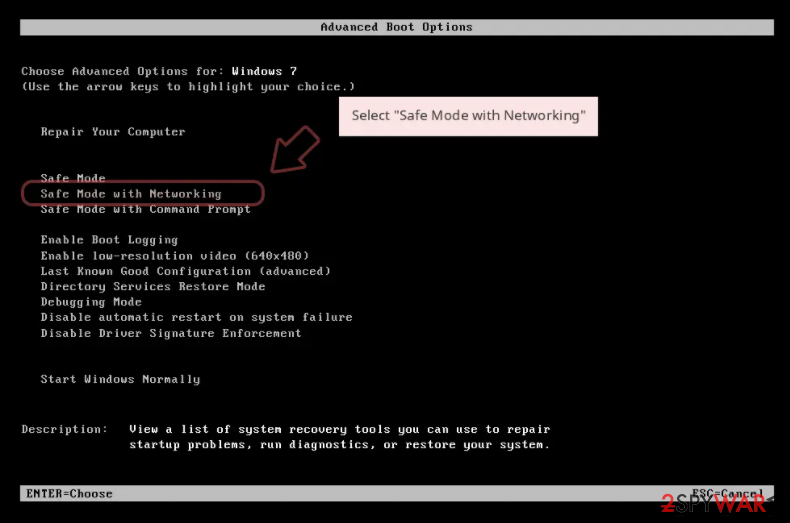
Windows 10 / Windows 8
- Right-click on Start button and select Settings.
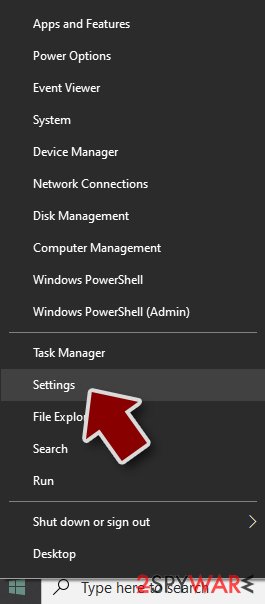
- Scroll down to pick Update & Security.
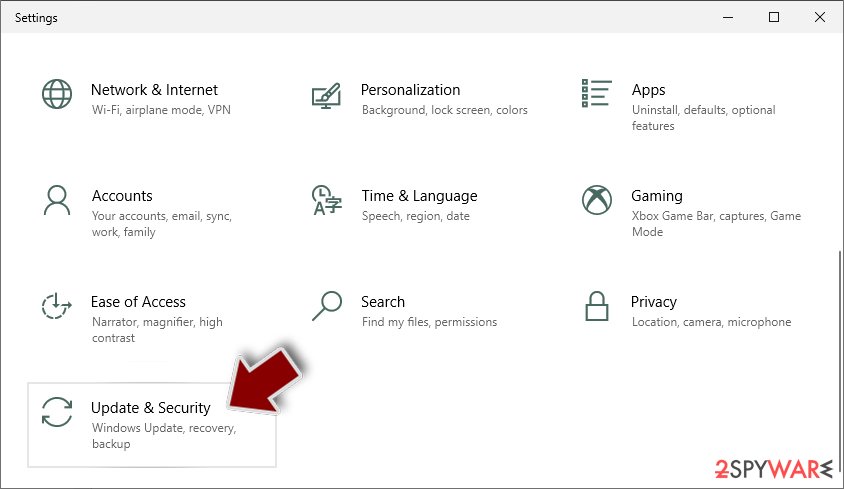
- On the left side of the window, pick Recovery.
- Now scroll down to find Advanced Startup section.
- Click Restart now.
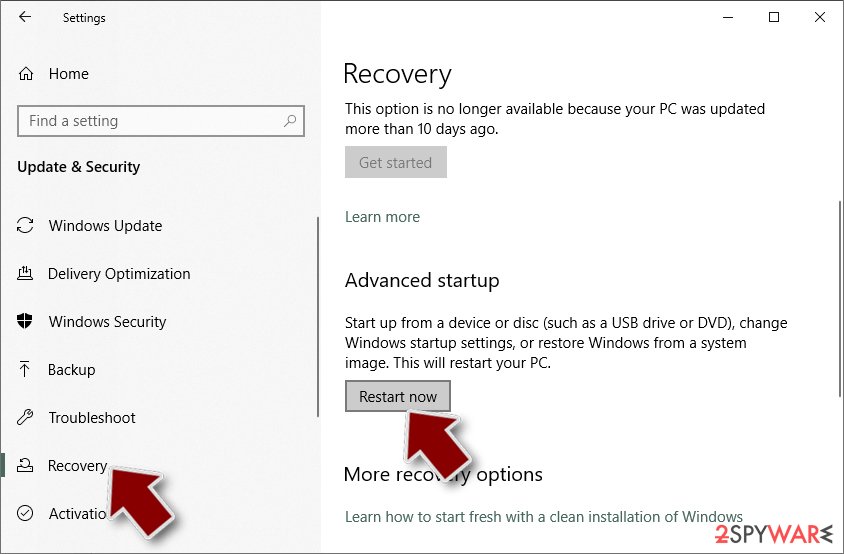
- Select Troubleshoot.
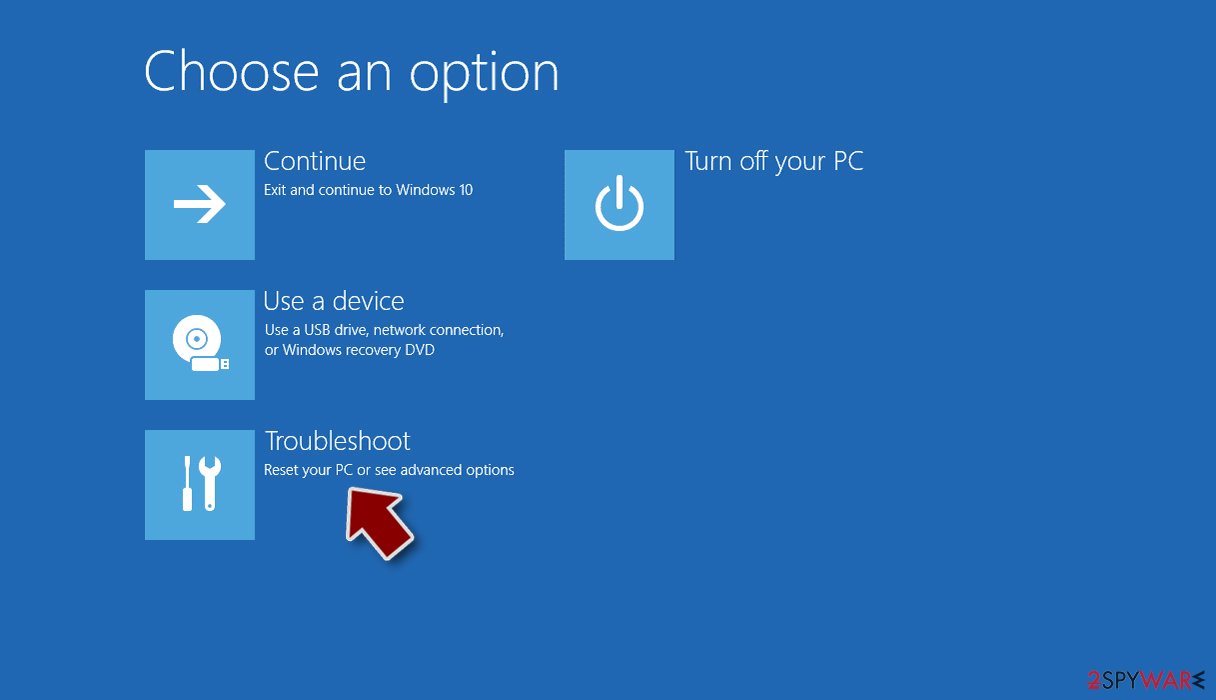
- Go to Advanced options.
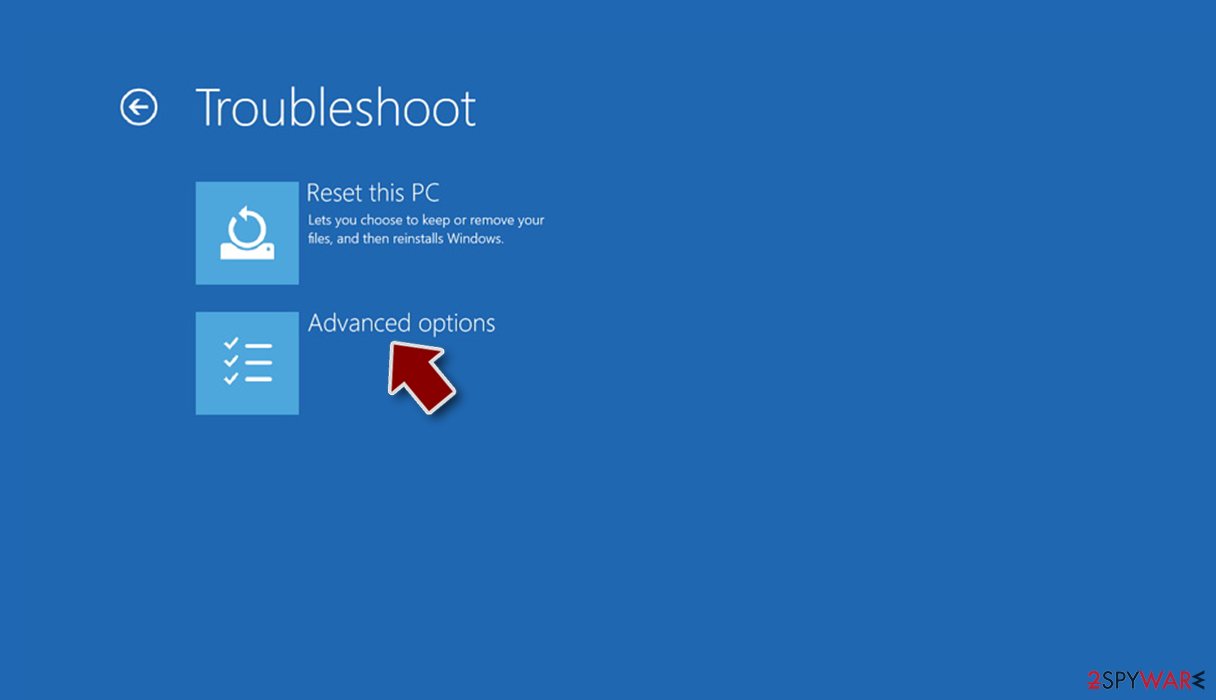
- Select Startup Settings.
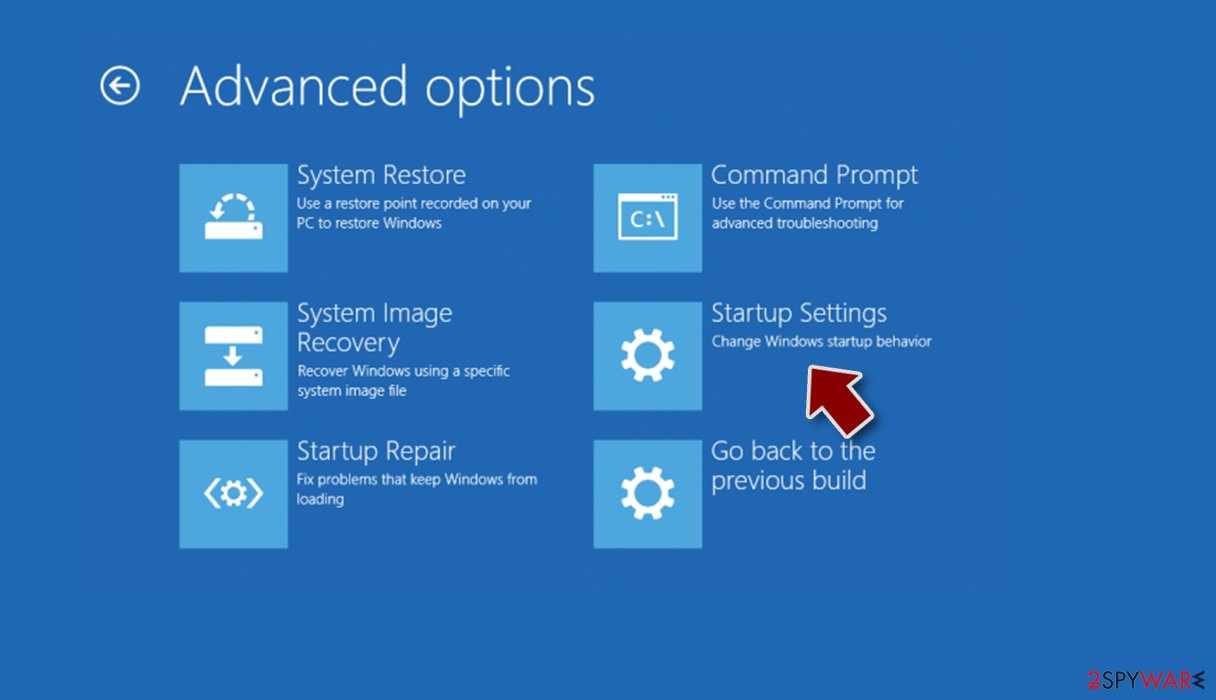
- Press Restart.
- Now press 5 or click 5) Enable Safe Mode with Networking.
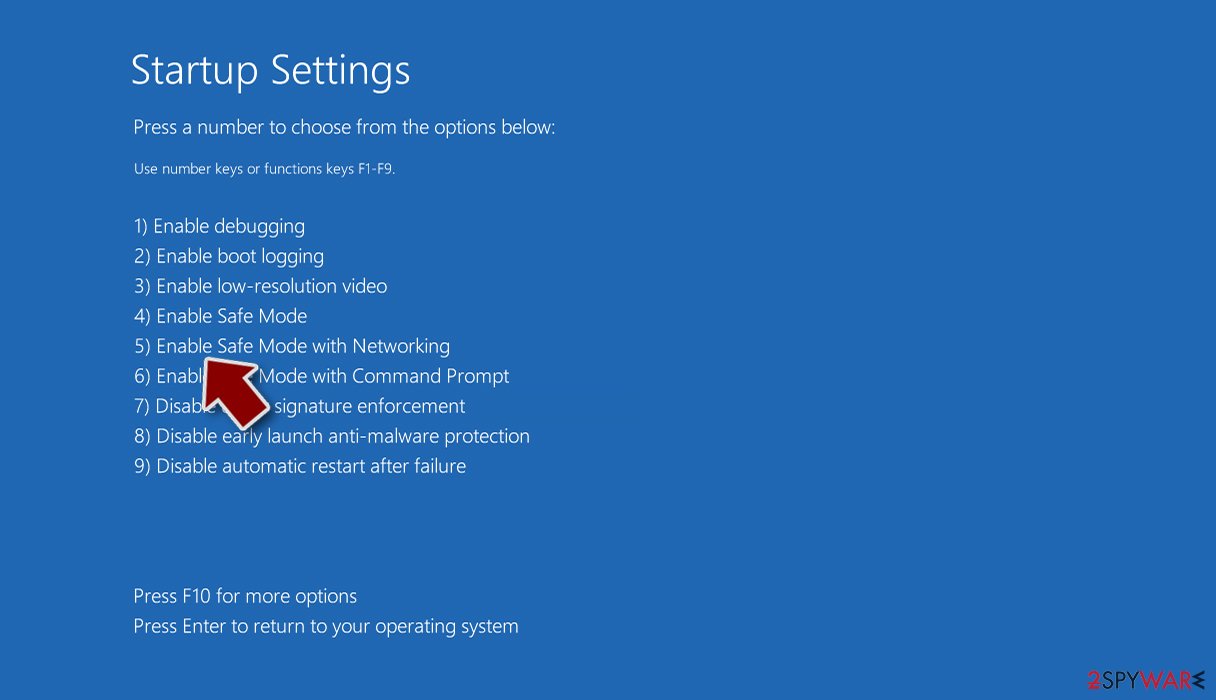
Step 2. Shut down suspicious processes
Windows Task Manager is a useful tool that shows all the processes running in the background. If malware is running a process, you need to shut it down:
- Press Ctrl + Shift + Esc on your keyboard to open Windows Task Manager.
- Click on More details.
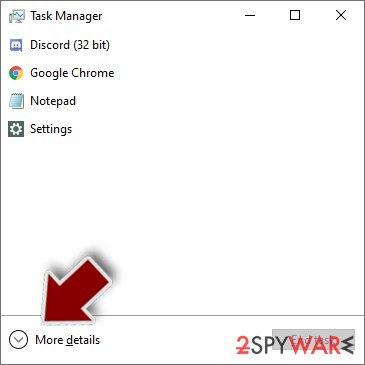
- Scroll down to Background processes section, and look for anything suspicious.
- Right-click and select Open file location.
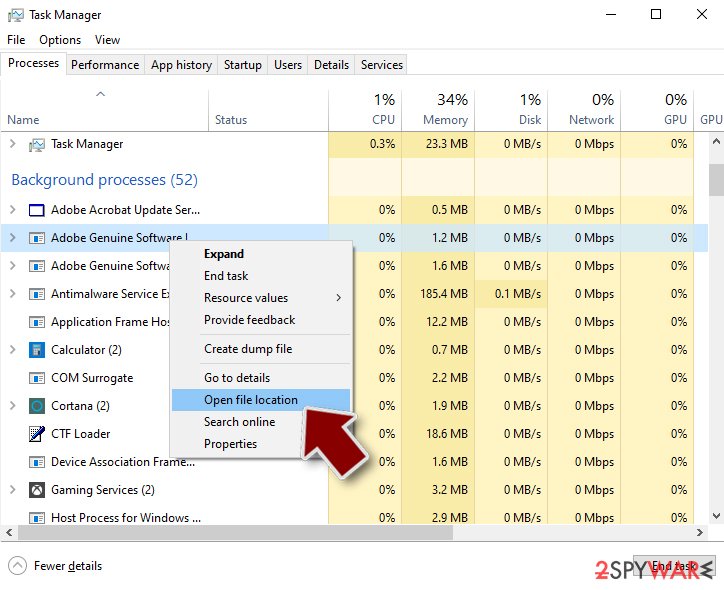
- Go back to the process, right-click and pick End Task.
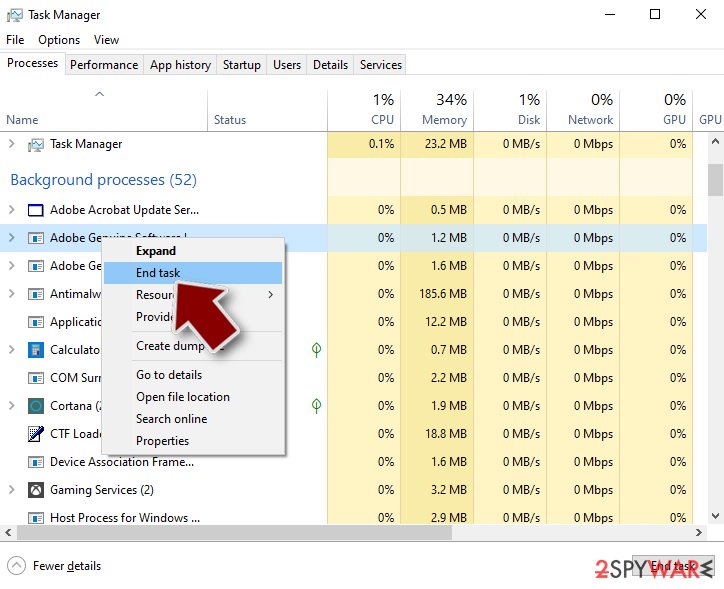
- Delete the contents of the malicious folder.
Step 3. Check program Startup
- Press Ctrl + Shift + Esc on your keyboard to open Windows Task Manager.
- Go to Startup tab.
- Right-click on the suspicious program and pick Disable.
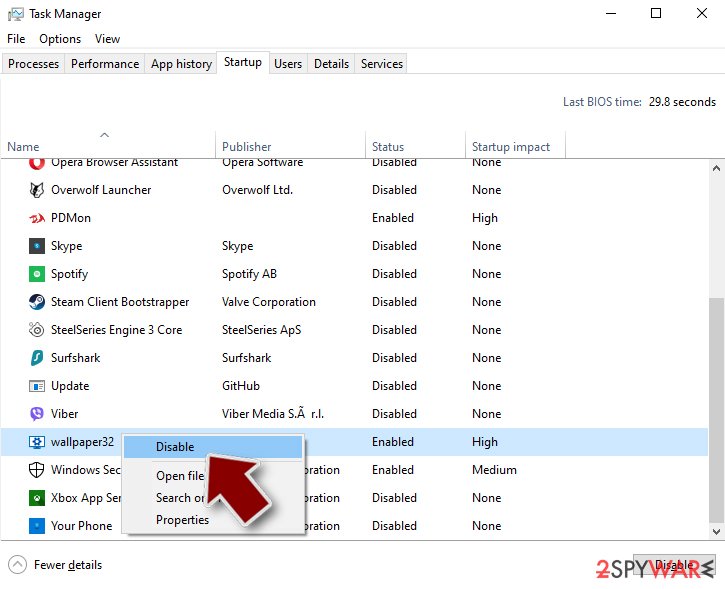
Step 4. Delete virus files
Malware-related files can be found in various places within your computer. Here are instructions that could help you find them:
- Type in Disk Cleanup in Windows search and press Enter.
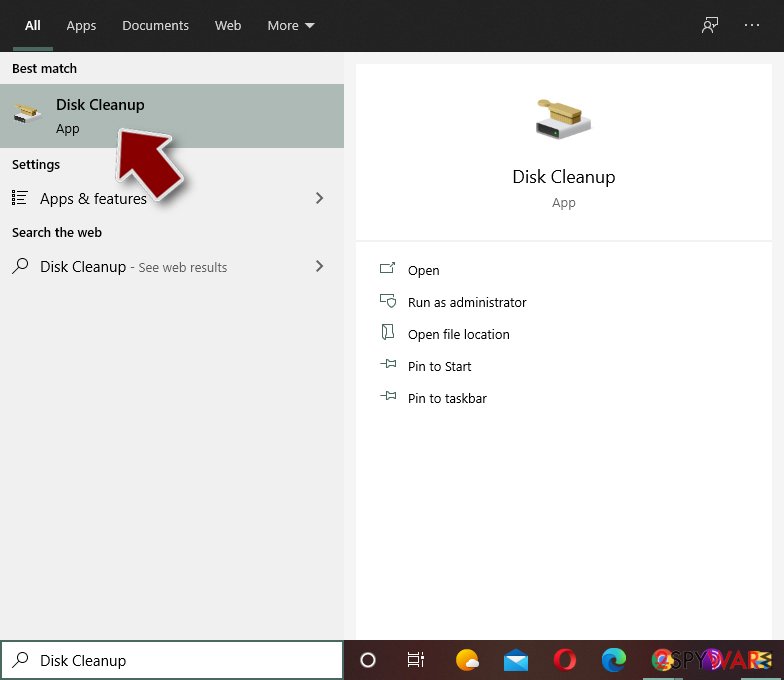
- Select the drive you want to clean (C: is your main drive by default and is likely to be the one that has malicious files in).
- Scroll through the Files to delete list and select the following:
Temporary Internet Files
Downloads
Recycle Bin
Temporary files - Pick Clean up system files.
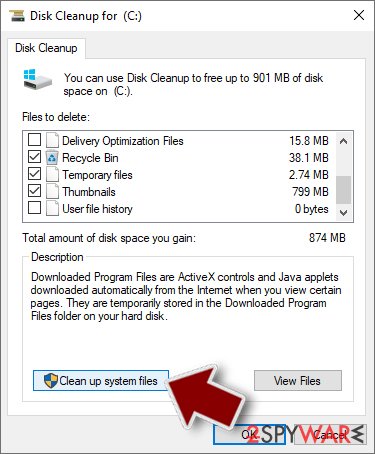
- You can also look for other malicious files hidden in the following folders (type these entries in Windows Search and press Enter):
%AppData%
%LocalAppData%
%ProgramData%
%WinDir%
After you are finished, reboot the PC in normal mode.
Remove EvilLock using System Restore
-
Step 1: Reboot your computer to Safe Mode with Command Prompt
Windows 7 / Vista / XP- Click Start → Shutdown → Restart → OK.
- When your computer becomes active, start pressing F8 multiple times until you see the Advanced Boot Options window.
-
Select Command Prompt from the list

Windows 10 / Windows 8- Press the Power button at the Windows login screen. Now press and hold Shift, which is on your keyboard, and click Restart..
- Now select Troubleshoot → Advanced options → Startup Settings and finally press Restart.
-
Once your computer becomes active, select Enable Safe Mode with Command Prompt in Startup Settings window.

-
Step 2: Restore your system files and settings
-
Once the Command Prompt window shows up, enter cd restore and click Enter.

-
Now type rstrui.exe and press Enter again..

-
When a new window shows up, click Next and select your restore point that is prior the infiltration of EvilLock. After doing that, click Next.


-
Now click Yes to start system restore.

-
Once the Command Prompt window shows up, enter cd restore and click Enter.
Bonus: Recover your data
Guide which is presented above is supposed to help you remove EvilLock from your computer. To recover your encrypted files, we recommend using a detailed guide prepared by 2-spyware.com security experts.If your files are encrypted by EvilLock, you can use several methods to restore them:
Install Data Recovery Pro
You can try to recover some of the encrypted data by using Data Recovery Pro. This data recovery software usually helps to restore encrypted/deleted/corrupted data, so we highly recommend using it.
- Download Data Recovery Pro;
- Follow the steps of Data Recovery Setup and install the program on your computer;
- Launch it and scan your computer for files encrypted by EvilLock ransomware;
- Restore them.
Windows Previous Versions
If you have created a restore point back in the day, you can restore individual files by using Windows Previous Versions. This is how you do it:
- Find an encrypted file you need to restore and right-click on it;
- Select “Properties” and go to “Previous versions” tab;
- Here, check each of available copies of the file in “Folder versions”. You should select the version you want to recover and click “Restore”.
Finally, you should always think about the protection of crypto-ransomwares. In order to protect your computer from EvilLock and other ransomwares, use a reputable anti-spyware, such as FortectIntego, SpyHunter 5Combo Cleaner or Malwarebytes
How to prevent from getting ransomware
Do not let government spy on you
The government has many issues in regards to tracking users' data and spying on citizens, so you should take this into consideration and learn more about shady information gathering practices. Avoid any unwanted government tracking or spying by going totally anonymous on the internet.
You can choose a different location when you go online and access any material you want without particular content restrictions. You can easily enjoy internet connection without any risks of being hacked by using Private Internet Access VPN.
Control the information that can be accessed by government any other unwanted party and surf online without being spied on. Even if you are not involved in illegal activities or trust your selection of services, platforms, be suspicious for your own security and take precautionary measures by using the VPN service.
Backup files for the later use, in case of the malware attack
Computer users can suffer from data losses due to cyber infections or their own faulty doings. Ransomware can encrypt and hold files hostage, while unforeseen power cuts might cause a loss of important documents. If you have proper up-to-date backups, you can easily recover after such an incident and get back to work. It is also equally important to update backups on a regular basis so that the newest information remains intact – you can set this process to be performed automatically.
When you have the previous version of every important document or project you can avoid frustration and breakdowns. It comes in handy when malware strikes out of nowhere. Use Data Recovery Pro for the data restoration process.
- ^ Tweet by @PolarToffee. Twitter. Online news and social networking service.
- ^ Advanced Encryption Standard. Wikipedia. The Free Encyclopedia.
- ^ Brute-force attack. Wikipedia. The Free Encyclopedia.
- ^ Lynsey Barber. Bitcoin still "currency of choice" for cybercriminals... for now. City A.M. Latest UK and World business and finance news.
- ^ How is malware distributed?. University of Delaware. Faculty who need a site for publicizing research work.







